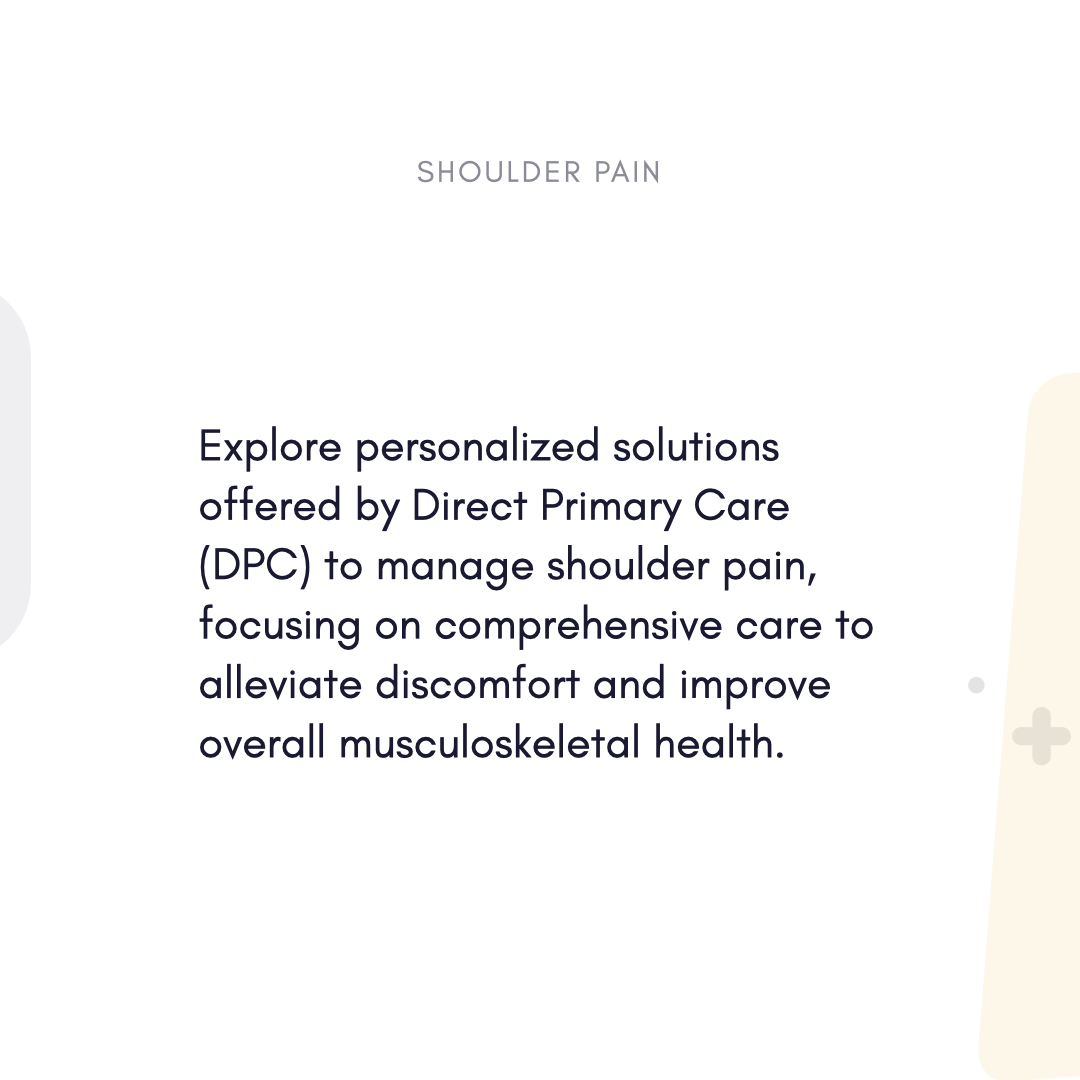Shoulder Pain and Direct Primary Care (DPC): Your Roadmap to Personalized Relief
You're not alone if you have ever gasped while reaching for a high shelf or battled to sleep with a throbbing shoulder. About one in four adults experience shoulder pain at some point, usually interfering with daily activities and restricting movement. From frozen shoulder to rotator cuff tears, untreated problems can cause lifelong disability. However, there is hope: Direct Primary Care (DPC) provides a patient-centered, simplified approach to shoulder pain with an eye toward fast diagnosis, customized treatments, and cost transparency.

Appreciating Shoulder Pain and Its Effects
There are several reasons why one may have shoulder pain, including:
- Rotator cuff problems (tears, tendinitis)
- Frozen shoulder, also known as adhesive capsulitis
- Arthritis, more especially osteoarthritis and rheumatoid arthritis
- Strains of the ligaments or bursitis
- Referred pain—that from heart diseases or neck problems
Typical complaints include:
- Aches either sharp or dull during motion
- Reduced range of motion and stiffness
- Error in lifting objects
- Night pain interfering with restful sleep
Untreated shoulder pain carries long-term hazards:
- Either joint deformity or chronic stiffness
- Muscle shrinkage brought on by disuse
- More reliance on painkillers
DPC Shapes Management of Shoulder Problems
Under the membership-based Direct Primary Care (DPC) model, consumers pay a monthly fee usually between 50 USD and 150 USD for unlimited access to their primary care physician. This means that for those with shoulder pain, insurance hassles, same-day visits, and care plans as tailored to your injury.
Here's why DPC distinguishes itself:
1. Fast, Evidence-Based Treatment
Guidelines from the American College of Physicians (ACP) and American Academy of Orthopaedic Surgeons (AAOS) guide DPC doctors including:
- Clinical tests to separate rotator cuff injuries from frozen shoulder or arthritis allow for quick diagnosis.
- Prescription physical therapy, NSAIDs (such as ibuprofen), or corticosteroid injections to lower inflammation first line treatments.
- Coordinating MRIs or orthopedic consults just when needed will help to prevent overtesting.
2. Reasonably reasonable, open pricing
- DPC clinics provide drugs like NSAIDs at wholesale rates, so cutting costs.
- Offering discounted relationships with nearby physical therapists or internal physical therapy guides.
- Steer clear of needless imaging (the ACP finds that half of shoulder MRIs are avoidable).
3. Constant Support for Long-Term Recovery
- Having 24/7 access to your DPC doctor allows you to rapidly change treatments should blisters spread or pain aggravation worsen.
- Track development in pain journals or mobility drills.
- Deal with basic problems including bad posture or office ergonomics.
DPC Benefits for Shoulder Pain Patients: Customized Treatment Plans
- Spending thirty to sixty minutes each visit, DPC doctors create plans including home exercise programs to build rotator cuff muscles.
- Combining treatments (e.g., melatonin for sleep disturbance combined with ice/heat treatment).
- Stress-management strategies help to lower flare-ups linked to tension.
Preventive Approach
DPC stresses the need of stopping chronic pain before it starts by:
- Ergonomic evaluations for athletes or office workers.
- Advice on nutrition to cut inflammatory foods (processed carbohydrates, sugar).
- Vaccines (such as those preventing shingles, which could replicate shoulder pain).
Perfect Coordination for Specialists
- DPC doctors negotiate cash-pay discounts with reputable orthopedists should advanced care or surgery be required.
- Share your complete medical history to help to prevent needless tests.
Personal Success Stories from Real Life
- Case 1: For months Sarah, 45, suffered with shoulder pain misdiagnosed as arthritis. Her DPC doctor helped her avoid surgery by spotting a rotator cuff strain, writing a focused PT prescription. In ten weeks she fully recovered.
- Case 2: Cost drove Tom, 55, to skip PT. By offering free resistance bands and a tailored home exercise program, his DPC clinic saved him 1,200 USD in co-pays.
Often asked questions: DPC and shoulder pain
- Q: Is it possible to heal shoulder pain without surgery?
- A: With sensible treatment, most cases get better. First in line with AAOS recommendations, DPC emphasizes non-invasive solutions.
- Q: For ongoing pain, is DPC reasonably priced?
- A: True. Avoiding ER visits, inflated imaging costs, and pointless referrals saves members 20–50% on average.
- Q: What if I require a specialist or MRI?
- A: Often securing imaging at 40–60% less than insurance-based rates, DPC doctors coordinate referrals.
Why DPC Will Help Those With Shoulder Pain?
The ACP emphasizes DPC's capacity to improve patient-provider ties and cut wastefulness in spending This translates for shoulder pain as:
- Early intervention stops chronic problems, so improving diagnosis.
- Treating the whole person—not just symptoms—is known as holistic care.
- Financial clarity: Not surprising bills for visits, emails, or follow-ups.
Empower Your Shoulder Health Right Now
Let shoulder pain not control your life. DPC helps you to find a partner who listens, creative thinker, and gives your recovery top priority—not insurance targets.






